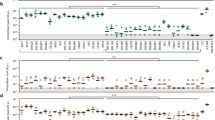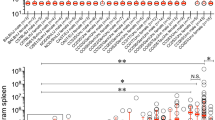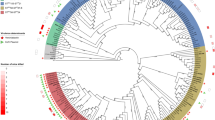Abstract
The Gram-negative bacteria, Salmonella, cause a broad spectrum of clinical diseases in both animals and humans ranging from asymptomatic carriage to life-threatening sepsis. We have developed a model to study the contribution of genetic factors to the susceptibility of 129sv and C57BL/6J inbred mice to Salmonella enteritidis during the late phase of infection. C57BL/6J mice were able to eliminate completely sublethal inoculums of S. enteritidis from their reticuloendothelial system, whereas 129sv mice could not even after 60 days post inoculation. A genome scan performed on 302 (C57BL/6J × 129sv) F2 progeny identified three dominant loci (designated Ses1 to Ses3) that are associated with disease susceptibility in 129sv mice. Two highly significant linkages were identified on chromosomes 1 (Ses1) and 7 (Ses2) with respective LOD scores of 9.9 (P = 1.4 × 10−11) at D1Mcg5 and 4.0 (P = 1.9 × 10−5) at D7Mit62. One highly suggestive QTL was located on chromosomes15 (Ses3) with a LOD score 3.4 (P = 1.2 × 10−4). The estimated effects of Ses1, Ses2 and Ses3 on the bacterial clearance were greater in females. Using a model of three loci, with interaction between Ses1 and Ses2 and sex as a covariate, the three QTLs explained 32% of the phenotypic variance. The candidacy of Nramp1 as the gene for Ses1 was evaluated using mice carrying a null allele at Nramp1 (129sv-Nramp1tm1Mcg). These mice have a significantly lower spleen bacterial load compared to the wild-type 129sv mice, strongly suggesting the involvement of Nramp1 in controlling S. enteritidis clearance during the late phase of infection.
This is a preview of subscription content, access via your institution
Access options
Subscribe to this journal
Receive 6 digital issues and online access to articles
$119.00 per year
only $19.83 per issue
Buy this article
- Purchase on Springer Link
- Instant access to full article PDF
Prices may be subject to local taxes which are calculated during checkout







Similar content being viewed by others
References
Center for Disease Control and Prevention report. Division of Bacterial and Mycotic Diseases. Disease Information December 2000
Francis CL, Starnbach MN, Falkow S . Morphological and cytoskeletal changes in epithelial cells occur immediately upon interaction and Salmonella typhimurium grown under low-oxygen conditions Mol Microbiol 1992 6: 3077–3087
Ohl ME, Miller SI . Salmonella: a model for bacterial pathogenesis Annu Rev Med 2001 52: 259–274
Chow JC, Young DW, Golenbock DT, Christ WJ, Gusovsky F . Toll-like receptor-4 mediates lipopolysaccharide-induced signal transduction J Biol Chem 1999 274: 10689–10692
Hayashi F, Smith KD, Ozinski A et al. The innate immune response to bacteria flagellin is mediated by Toll-like receptor 5 Nature 2001 410: 1099–1103
Carter PB, Collins FM . Peyer’s patch responsiveness to Salmonella in mice J Reticuloendothel Soc 1975 17: 38–46
Hormaeche CE, Harrington KA, Joysey HS . Natural resistance to Salmonellae in mice: control by genes within the major histo-compatibility complex J Infect Dis 1985 152: 1050–1056
Nauciel C, Ronco E, Guenet JL, Pla M . Role of H-2 and non-H-2 genes in control of bacterial clearance from the spleen in Salmonella typhimurium-infected mice Infect Immun 1988 56: 2407–2411
Vidal SM, Malo D, Vogan K, Skamene E, Gros P . Natural resistance to infection with intracellular parasites: isolation of a candidate for Bcg Cell 1993 73: 469–485
Thomas JD, Sideras P, Smith CIE, Vorechovsky I, Chapman V, Paul WE . Colocalization of X-linked agammaglobulinemia and X-linked immunodeficiency genes Science 1993 261: 355–358
Rawlings DJ, Saffran DC, Tsukada S et al. Mutation of unique region of Bruton’s tyrosine kinase in immunodeficient XID mice Science 1993 261: 358–361
Segre JA, Nemhauser JL, Taylor BA, Nadeau JH, Lander ES . Positional cloning of the nude locus: genetic, physical and transcriptional maps of the region and mutations in the mouse and rat Genomics 1995 28: 549–559
Poltorak A, He X, Smirnova I, Liu MY, Huffel CV, Du X . Defective LPS signaling in C3H/HeJ and C57BL/10ScCr mice: mutations in Tlr4 gene J Infect Dis 1998 282: 2085–2088
Qureshi ST, Larivière L, Leveque G et al. Endotoxin-tolerant mice have mutations in Toll-like receptor 4 (Tlr4) J Exp Med 1999 189: 615–625
Lengeling A, Pfeffer K, Balling R . The battle of two genomes: genetics of bacterial host/pathogen interactions in mice Mamm Genome 2001 12: 261–271
Sebastiani G, Olien L, Gauthier S et al. Mapping of genetic modulators of natural resistance to infection with Salmonella Typhimurium in wild-derived mice Genomics 1998 47: 180–186
Qureshi ST, Larivière L, Sebastiani G et al. A high-resolution map in the chromosomal region surrounding the Lps locus Genomics 1996 31: 283–294
Cellier M, Privé G, Belouchi A et al. Nramp defines a family of membrane proteins Proc Natl Acad Sci USA 1995 92: 10089–10093
Belouchi A, Cellier M, Kwan T, Saini HS, Leroux G, Gros P . The macrophage-specific membrane protein Nramp controlling natural resistance to infections in mice has homologues expressed in the root system of plants Plant Mol Biol 1995 29: 1181–1196
Hu J, Bumstead N, Skamene E, Gros P, Malo D . Structural organization, sequence and expression of the chicken NRAMP1 gene encoding the natural resistance associated macrophage protein 1 DNA Cell Biol 1996 15: 113–123
Supek F, Supekova L, Nelson H, Nelson N . A yeast manganese transporter related to the macrophage protein involved in conferring resistance to Mycobacteria Proc Natl Acad Sci USA 1996 93: 5105–5110
Cellier M, Belouchi A, Gros P . Resistance to intracellular infection: comparative genomic analysis of Nramp Trends Genet 1996 12: 201–204
Feng J, Li Y, Hashad M et al. Bovine natural resistance associated macrophage protein 1 (Nramp1) gene Genome Res 1996 6: 956–964
Agranoff D, Monahan IM, Mangan JA, Butcher PD, Krishna S . Mycobacterium tuberculosis expresses a novel pH-dependent divalent cation transporter belonging to the Nramp Family J Exp Med 1999 190: 717–724
Saeij JP, Wiegertjes GF, Stet RJ . Identification and characterization of a fish natural resistance-associated macrophage protein (NRAMP) cDNA Immunogenetics 1999 50: 60–66
Makui H, Roig E, Cole ST, Helmann JD, Gros P, Celllier MF . Identification of the Escherichia coli K-12 Nramp orthologue (MntH) as a selective divalent metal ion transporter Mol Microbiol 2000 35: 1065–1078
Gruenheid S, Pinner E, Desjardins M, Gros P . Natural resistance to infection with intracellular pathogens: the Nramp1 protein is recruited to the membrane of the phagosome J Exp Med 1997 185: 717–730
Jabado N, Jankowski A, Dougaparsad S, Picard V, Grinstein S, Gros P . Natural resistance to intracellular infections: natural resistance-associated macrophage resistance protein 1 (Nramp1) functions as a pH-dependent Manganese transporter at the phagosomal membrane J Exp Med 2000 192: 1237–1247
Schweitzer AN, Sharpe AH . Studies using antigen-presenting cells lacking expression of both B7-1 (CD80) and B7-2 (CD86) show distinct requirements for B7 molecules during priming versus restimulation of TH2 but not TH1 cytokine production J Immunol 1998 161: 2762–2771
Nauciel C . Role of CD4+ T cells and T-independent mechanisms in acquired resistance to Salmonella typhimurium infection J Immunol 1990 145: 1265–1269
Mittrucker HW, Kohler A, Mak TW, Kaufmann SHE . Critical role of CD28 in protective immunity against Salmonella typhimurium J Immunol 1999 163: 6769–6776
Simpson EM, Liner CC, Sargent EE, Davisson MT, Mobraaten LE, Sharp JJ . Genetic variation among 129 substrains and its importance for targeted mutagenesis in mice Nat Gen 1997 16: 19–27
Lander E, Kruglyak L . Genetic dissection of complex traits: guidelines for interpreting and reporting linkage results Nat Genet 1995 11: 241–247
Vidal S, Tremblay ML, Govoni G et al. The Ity/Lsh/Bcg locus: natural resistance to infection with intracellular parasites is abrogated by disruption of the Nramp1 gene J Exp Med 1995 182: 655–666
Eckmann L, Fierer J, Kagnoff MF . Genetically resistant (Ityr) and susceptible (Itys) congenic mouse strains show similar cytokine responses following infection with Salmonella dublin J Immunol 1996 156: 2894–2900
Soo SS, Villarreal-Ramos B, Anjam Khan CM, Hormaeche CE, Blackwell JM . Genetic control of immune response to recombinant antigens carried by an attenuated Salmonella typhimurium vaccine strain: Nramp1 influences T-helper subset responses and protection against leishmanial challenge Infect Immun 1998 66: 1910–1917
Hormaeche CE . Natural resistance to Salmonella typhimurium in different inbred mouse strains Immunology 1979 37: 311–318
Qureshi S, Skamene E, Malo D . Genetic regulation of host responses to Salmonella typhimurium In Paradise LJ, Friedman H, Bendinelli M (eds) Opportunistic Intracellular Bacteria and Immunity Plenum Press: New York 1999 pp 17–36
Whitacre CC, Reingold SC, O’Looney PA . A gender gap in autoimmunity Science 1999 283: 1277–1278
Huygen K, Palfliet K . Strain variation in interferon gammaproduction of BCG-sensitive mice challenged with PPD II. Importance of one major autosome locus and additional sexual influences Cell Immunol 1984 85: 85–75
Li P, Allen H, Banerjee S et al. Mice deficient in IL-1β-converting enzyme are defective in production of mature IL-1 and resistant to endotoxic shock Cell 1995 80: 401–411
Shimomura K, Low-Zeddies SS, King DP et al. Genome-wide epistatic interaction analysis reveals complex genetic determinants of circadian behavior in mice Genome Res 2001 11: 959–980
Skamene E, Schurr E, Gros P . Infection genomics: Nramp1 as a major determinant of natural resistance to intracellular infections Annu Rev Med 1998 49: 275–285
Wojciechowski W, DeSanctis J, Skamene E, Radzioch D . Attenuation of MHC class II expression in macrophages infected with Mycobacterium bovis Bacillus Calmette-Guerin involves class II transactivator and depends on the Nramp1 gene J Immunol 1999 163: 2688–2696
Blackwell JM, Black GF, Sharples C, Soo SS, Peacock CS, Miller N . Roles of Nramp1, HLA, and a gene(s) in allelic association with IL4, in determining T helper subset differentiation Microbes Infect 1999 1: 95–102
Meresse S, Steele-Mortimer O, Moreno E, Desjardins M, Finlay B, Gorvel JP . Controlling the maturation of pathogen-containing vacuoles: a matter of life and death Nat Cell Biol 1999 1: E183–E188
Govoni G, Gauthie S, Billia F, Iscove NN, Gros P . Cell-specific and inducible Nramp1 gene expression in mouse macrophages in vitro and in vivo J Leukoc Biol 1997 62: 277–286
Govoni G, Cannone-Hergaux F, Pfeifer CG et al. Functional expression of Nramp 1 in vitro in the murine macrophage line RAW264.7 Infect Immun 1999 67: 2225–2232
Abel L, Sanchez FO, Oberti J et al. Susceptibility to leprosy is linked to the human NRAMP1 gene J Infect Dis 1998 177: 133–145
Alcais A, Sanchez FO, Thuc NV et al. Granulomatous reaction to intradermal injection of lepromin (Mitsuda reaction) is linked to the human NRAMP1 gene in Vietnamese leprosy patients J Infect Dis 2000 181: 302–308
Cruikshank WW, Kornfeld H, Center DM . Interleukin-16 J Leuk Biol 2000 67: 757–766
Gaffen SL . Signaling domains of the interleukin 2 receptor Cytokine 2001 14: 63–77
Cassatella MA, McDonald PP . Interleukin-15 and its impact on neturophil function Curr Opin Hematol 2000 7: 174–177
Kirman I, Vainer B, Nielsen OH . Interleukin-15 and its role in chronic inflammatory diseases Inflamm Res 1998 47: 285–289
Apostolopoulos J, McKenzie IF, Sandrin MS . Ly6d-L, a cell surface ligand for mouse Ly6d Immunity 2000 12: 223–232
Manly KF, Cudmore RH Jr, Meer JM . Map Manager QTX, cross-platform software for genetic mapping Mammal Genome 2001 12: 930–932
Lander ES, Green P, Abrahamson J et al. MAPMAKER: an interactive computer package for constructing primary genetic linkage maps of experimental and natural populations Genomics 1987 1: 174–181
Basten CJ, Weir BS, Zeng ZB . Zmap-a QTL cartographer In: Smith C, Gavora JS, Benkel B et al (eds) Proceedings of the 5th World Congress on Genetics Applied to Livestock Production: Computing Strategies and Software Organizing Committee, 5th World Congress on Genetics Applied to Livestock Production: Guelph 1994 pp 65–66
Basten CJ, Weir BS, Zeng ZB . QTL Cartographer, Version 1.15 Departmnet of Statistics, North Carolina State University, Raleigh 2001
Malo D, Vogan K, Vidal S et al. Haplotype mapping and sequence analysis of the mouse Nramp gene predict susceptibility to infection with intracellular parasites Genomics 1994 23: 51–61
Acknowledgements
We thank Dr Philippe Gros for providing Nramp1 knock out mice; Dr William Kay for providing S. enteritidis isolates; and Franck Bihl and Silvia Vidal for discussions.
Author information
Authors and Affiliations
Corresponding author
Additional information
This work was supported by grants from the Canadian Networks of Centers of Excellence Program – the Canadian Genetic Diseases Network (CGDN, KM), the Mathematics of Information Technology and Complex Systems Network (MITACS, KM) and the Canadian Bacterial Diseases Network (CBDN, DM); the Canadian Institutes of Health Research (CIHR) and the Howard Hughes Medical Institute (Infectious Diseases and Parasitology Program).
Rights and permissions
About this article
Cite this article
Caron, J., Loredo-Osti, J., Laroche, L. et al. Identification of genetic loci controlling bacterial clearance in experimental Salmonella enteritidis infection: an unexpected role of Nramp1 (Slc11a1) in the persistence of infection in mice. Genes Immun 3, 196–204 (2002). https://doi.org/10.1038/sj.gene.6363850
Received:
Revised:
Accepted:
Published:
Issue Date:
DOI: https://doi.org/10.1038/sj.gene.6363850
Keywords
This article is cited by
-
Expression kinetics of natural resistance associated macrophage protein (NRAMP) genes in Salmonella Typhimurium-infected chicken
BMC Veterinary Research (2018)
-
Female partner preferences enhance offspring ability to survive an infection
BMC Evolutionary Biology (2014)
-
Functional validation of the genetic architecture of Salmonella Enteritidis persistence in 129S6 mice
Mammalian Genome (2013)
-
Impact of Usp18 and IFN signaling in Salmonella-induced typhlitis
Genes & Immunity (2011)
-
A locus on chromosome 9 is associated with differential response of 129S1/SvImJ and FVB/NJ strains of mice to systemic LPS
Mammalian Genome (2011)



